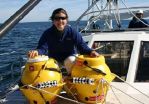(Press-News.org) By analyzing data on multilingual Twitter users and Wikipedia editors and on 30 years' worth of book translations in 150 countries, researchers at MIT, Harvard University, Northeastern University, and Aix Marseille University have developed network maps that they say represent the strength of the cultural connections between speakers of different languages.
This week, in the Proceedings of the National Academy of Sciences, they show that a language's centrality in their network -- as defined by both the number and the strength of its connections -- better predicts the global fame of its speakers than either the population or the wealth of the countries in which it is spoken.
"The network of languages that are being translated is an aggregation of the social network of the planet," says Cesar Hidalgo, the Asahi Broadcasting Corporation Career Development Assistant Professor of Media Arts and Sciences and senior author on the paper. "Not everybody shares a language with everyone else, and therefore the global social network is structured through these circuitous paths in which people in some language groups are by definition way more central than others. That gives them a disproportionate power and responsibility. On the one hand, they have a much easier time disseminating the content that they produce. On the other hand, as information flows through people, it gets colored by the ideas and the biases that those people have."
Plotting polyglots
Hidalgo and his students Shahar Ronen -- first author on the new paper -- and Kevin Hu, together with Harvard's Steven Pinker, Bruno Gonçalves of Aix Marseille University, and Alessandro Vespignani of Northeastern, included a given Twitter user in their data set if he or she had at least three sentence-long tweets in a language other than his or her primary language. That left them with 17 million of Twitter's roughly 280 million users. They had similar thresholds for Wikipedia users who had edited entries in more than one language, which gave them a data set of 2.2 million Wikipedia editors.
In both cases, the strength of the connection between any two languages was determined by the number of users who had demonstrated facility with both of them.
The translation data came from UNESCO's Index Translationum, which catalogues 2.2 million book translations, in more than 1,000 languages, published between 1979 and 2011. There, the strength of the connection between two languages was determined by the number of translations between them.
The researchers also used two different definitions of global fame. One was the measure that Hidalgo's group had used in its earlier Pantheon project, which also looked at global cultural production. Pantheon had identified everyone with (at the time) Wikipedia entries in at least 26 languages -- 11,340 people in all.
The other fame measure was inclusion among the 4,002 people profiled in the book "Human Accomplishment: The Pursuit of Excellence in the Arts and Sciences, 800 BC to 1950," by the American political scientist Charles Murray. Murray's list was based on the frequency with which people's names were mentioned in 167 reference texts -- encyclopedias and historical surveys -- published worldwide.
Relative correlatives
There were, naturally, differences between the networks produced from the separate data sets and their correlations with the two fame measures. For instance, in the network produced from Wikipedia data, German is much more central than Spanish; in the Twitter network, the opposite is true.
Similarly, the network produced from UNESCO's translation data correlated better with Murray's fame index, which, as the subtitle of his book indicates, concentrated on science and the arts. The Wikipedia and Twitter networks correlated better with the Pantheon index, which included many more pop-culture figures.
But with both fame measures, at least one of the networks, taken in isolation, provided better correlation than the number of speakers of a language and the GDPs of the countries in which it is spoken. And when the networks were combined with population and income data, the correlations were higher still.
"We have to be very clear about what we're talking about," Hidalgo says. "This paper is not about global languages. All three networks are representative of elites. But those elites are the ones that drive the transfer of information across cultures."
INFORMATION:
Written by Larry Hardesty, MIT News Office
Additional background
Global Language Network project site
http://language.media.mit.edu/
PRINCETON, N.J.--More than half of all American children will likely live with an unmarried mother at some point before they reach age 18, according to a report issued by Princeton University and Harvard University.
The absence of a biological father increases the likelihood that a child will exhibit antisocial behaviors like aggression, rule-breaking and delinquency, the researchers report in the journal EducationNext. This finding - which holds true regardless of a child's race - is especially prevalent among young boys. As a result, these children are 40 percent less ...
We humans have an exceptional age structure compared to other animals: Our children remain dependent on their parents for an unusually long period and our elderly live an extremely long time after they have stopped procreating.
Could the microscopic fellow travelers that consider the human body to be their home - collectively known as the microbiome - have played an active role in shaping and maintaining this unusual aspect of human nature?
That is the speculative proposition advanced by Martin Blaser, professor of medicine and microbiology at NYU's Langone Medical ...
Humpback whales have a trick or two, when it comes to finding a quick snack at the bottom of the ocean. But how they pinpoint that meal at night, with little or no available light, remains a mystery.
Susan Parks, assistant professor of Biology in Syracuse University's College of Arts and Sciences, in collaboration with a consortium of other researchers, has been studying these unique feeding behaviors. Her research emphasizes the importance of specific auditory cues that these mammoth creatures emit, as they search the deep ocean for their prey.
Her findings are the ...
Massachusetts General Hospital (MGH) investigators have developed a method of detecting, across the entire genome of human cells, unwanted DNA breaks induced by use of the popular gene-editing tools called CRISPR-Cas RNA-guided nucleases (RGNs). Members of the same team that first described these off-target effects in human cells describe their new platform, called Genome-wide Unbiased Indentification of DSBs Evaluated by Sequencing (GUIDE-seq), in a report being published online in Nature Biotechnology.
"GUIDE-seq is the first genome-wide method of sensitively detecting ...
ANN ARBOR--A national survey of students in U.S. middle schools and high schools shows some important improvements in levels of substance use.
Both alcohol and cigarette use in 2014 are at their lowest points since the study began in 1975. Use of a number of illicit drugs also show declines this year.
These findings come from the University of Michigan's Monitoring the Future study, which tracks trends in substance use among students in 8th, 10th and 12th grades. Each year the national study, now in its 40th year, surveys 40,000 to 50,000 students in about 400 secondary ...
The rate at which carbon emissions warmed Earth's climate almost 56 million years ago resembles modern, human-caused global warming much more than previously believed, but involved two pulses of carbon to the atmosphere, researchers have found.
The findings mean that the so-called Paleocene-Eocene thermal maximum, or PETM, can provide clues to the future of modern climate change.
The good news: Earth and most species survived.
The bad news: It took millennia to recover from the episode, when temperatures rose by 5 to 8 degrees Celsius (9 to 15 degrees Fahrenheit). ...
Researchers at Columbia University's Mailman School of Public Health analyzed the results of the Oregon Health Experiment, where eligible uninsured individuals were randomly assigned Medicaid or to stay with their current care. Considered controversial because the experiment found no measurable gains for physical health it did reveal benefits for mental health, financial wellbeing, and preventive screening. In terms of quality-adjusted life years, the researchers showed that Medicaid is an excellent value--a $62,000 gain in quality-adjusted life years. Study findings are ...
Antimicrobial peptides are a distinctive class of potent, broad-spectrum antibiotics produced by the body's innate immune system--the first line of defense against disease-causing microbes.
In a new study, Yixin Shi, Ph.D., and Wei Kong, Ph.D., researchers in the Center for Infectious Diseases and Vaccinology at Arizona State University's Biodesign Institute, explore the clever techniques used by bacteria to survive destruction from antimicrobial peptides--potent defense factors produced by all living forms, including humans.
Professor Shi underscores the importance ...
It may seem counterintuitive, but exercise can be beneficial for people suffering from arthritis and other muscle and joint conditions. A new study at Hospital for Special Surgery (HSS) finds that older adults experienced less pain, reduced stiffness and less fatigue after participating in a hospital-based exercise program.
"The study adds to the growing body of evidence that exercise can help people with muscle and joint conditions," said Sandra Goldsmith, MA, MS, RD, director of Public and Patient Education at Hospital for Special Surgery.
Up to 50 million adults ...
Home- and community-based HIV testing and counselling services can achieve high participation uptake in rural Africa but reach different populations within a community and should be provided depending on the groups that are being targeted, according to new research published in this week's PLOS Medicine by Niklaus Labhardt from the Swiss Tropical and Public Health Institute, and colleagues from SolidarMed, a Swiss non-governmental Organization for Health in Africa.
Annually, about 2.3 million people become newly infected with HIV, the virus that causes AIDS. A key step ...




